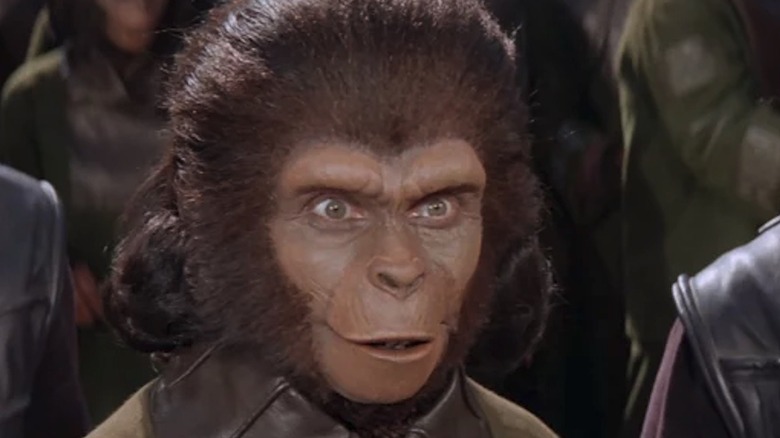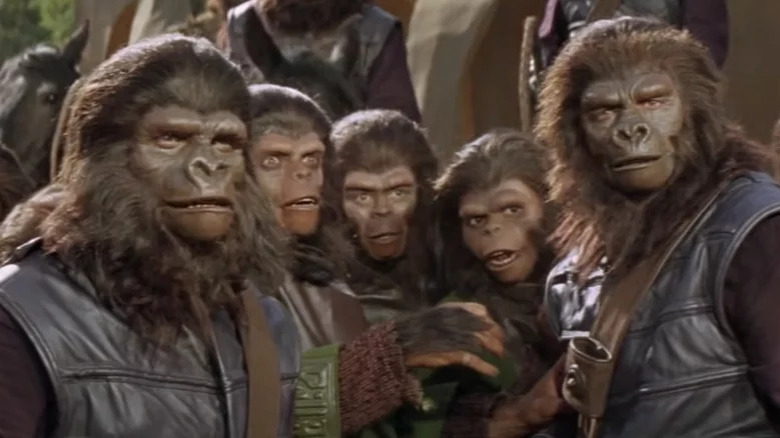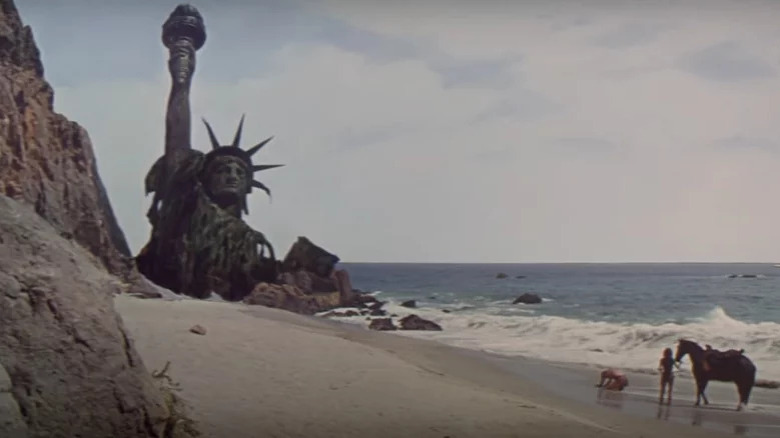Charlton Heston Went The Extra Mile To Protect Planet Of The Apes' Cast From The Brutal Heat
Sometimes we hear negative stories about famous actors on set. Egos get in the way of common courtesy, political leanings can color conversations, and working conditions can bring out the worst in people. Here's an actually lovely one instead. Prosthetic makeup is a tricky thing, and I say this as someone who has worn them in productions and been a makeup artist who applied them. They are not comfortable and can be very hot, itchy, and claustrophobic. Effects makeup has come a long way since the late 1960s when "Planet of the Apes" was shooting, and even now, it's not easy to wear. Back then, it must have been awful.
Add in the fact that, when shooting some of the scenes in the classic sci-fi film, the cast was out in the desert in 100-degree heat. The people playing the apes had major prosthetics on their faces, extra hair on their arms, and costumes. It wasn't exactly the healthiest situation, and it certainly couldn't have been comfortable for anyone.
As it turns out, star Charlton Heston was there to save the day, as we learn in the book "Planet of the Apes Revisited: The Behind-the-Scenes Story of the Classic Science Fiction Saga" by Joe Russo, Larry Landsman, and Edward Gross (via Huffington Post).
Going the extra mile
"Planet of the Apes," directed by Franklin J. Schaffner, was based on the 1963 French novel "La Planète des Singes" by Pierre Boulle. It was the story of astronauts (of which Heston was one) who crash land on a planet in the distant future where apes have evolved great intelligence, and the planet's humans are mute and primitive. If you're at all aware of the film (or if you've seen "The Simpsons" episode "A Fish Called Selma"), you know the twist ending.
The ape makeup was particularly heavy in the area of the mouth, and often when an actor wears makeup like that, it's difficult to drink anything. Dehydration is no joke, and the cast was having a rough time. In the book, actor Lou Wagner, who played Lucius in the film, says that Heston came to the rescue.
"It was like 100 degrees and people were fainting all the time on the crew and cast. We needed straws to drink because our mouth was so far behind the appliance we would ruin everything if we tried to drink. Chuck wasn't in a couple of scenes and he hiked about a mile all the way back to base camp and brought us back straws so we could have some water."
That wasn't all Heston — who was the head of the Screen Actors Guild at the time — did for the cast to make them more comfortable.
A champion of his fellow actors
The actors wearing the prosthetics had to get to the set at 3:30 in the morning, unlike Heston, who was playing a grubby human. When he found out about how long it took to get the makeup applied on the lot and then the drive out to the set in Malibu, California, he actually got a helicopter for the cast so they could sleep a little later in the morning, according to actor Kim Hunter who played Zira in the film.
It does make you wonder, though, why no one else was taking care of this if, as Wagner says, people in the cast and crew were actually fainting. This was obviously before the age of social media, where the news gets out, but still, those are terrible working conditions. It's nice to know that someone was actually looking out for the people involved in the film.
"Planet of the Apes" spawned four sequels, a 1974 TV series, then a reboot in 2001, then another in 2011, which had two sequels. The third sequel to the latest sequel is "Kingdom of the Planet of the Apes," which will hit theaters in 2024.


